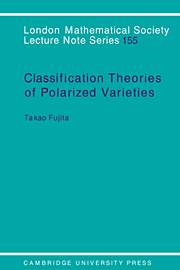Chapter IV - Related Topics and Generalizations
Published online by Cambridge University Press: 17 March 2010
Summary
Singular and quasi- polarized varieties
(19.1) In the preceding theories on polarized varieties we usually needed some conditions on singularities. This may look like just a technical matter, but it often involves very delicate problems. For example, let us consider the following.
(19.2) Conjecture. g(V, L) ≥ O for every polarized variety (V, L).
This assertion is verified in the following cases.
1) (V, L) has a ladder.
The proof is very easy. Thus there is no problem if L is spanned by global sections.
2) V is smooth and char(ℝ) = O (cf. (12.1)).
In fact, V may have certain mild singularities (e.g. log-terminal, see [F18], [F24;§3]).
3) V is a normal surface.
For a proof in this case, see [Sak2].
Despite these partial answers, the conjecture is still unproved in general.
(19.3) Here we present an approach for the study of singular polarized varieties. As an application, we prove Conjecture (19.2) in the case n = dim V ≤ 3.
Definition. A pair (V, L) of a variety V and a line bundle L on V will be called a quasi-polarized variety if L is nef and big (⇒ LC ≥ O for any curve C in V and Ln > O). Two such pairs (V1, L1) and (V2, L2) are said to be birationally equivalent to each other if there is another variety V' together with birational morphisms fi: V' → Vi (i = 1, 2) such that f1*L1 = f2*L2.
Under these notions, we can use various techniques in birational geometry.
- Type
- Chapter
- Information
- Classification Theory of Polarized Varieties , pp. 164 - 183Publisher: Cambridge University PressPrint publication year: 1990

